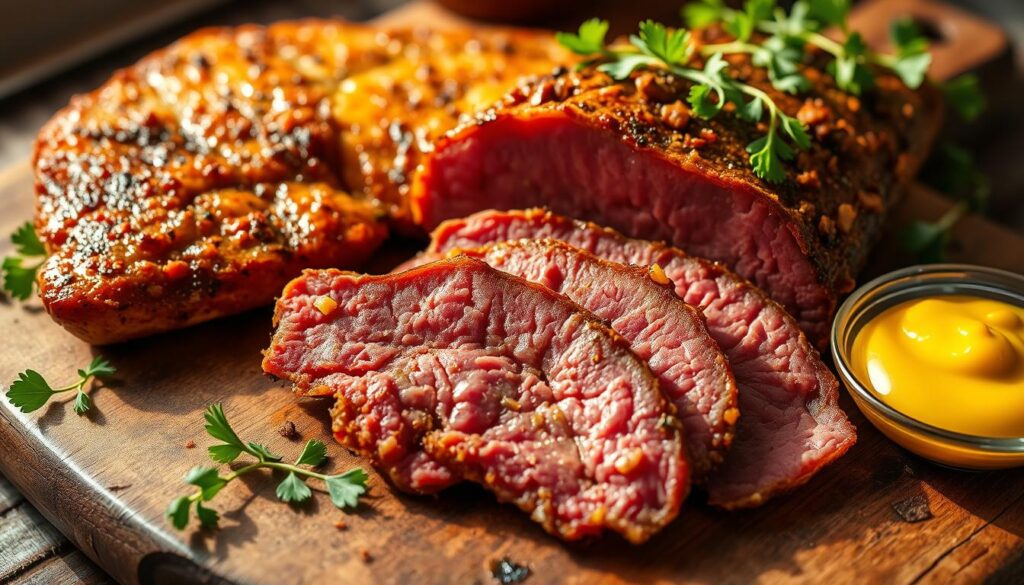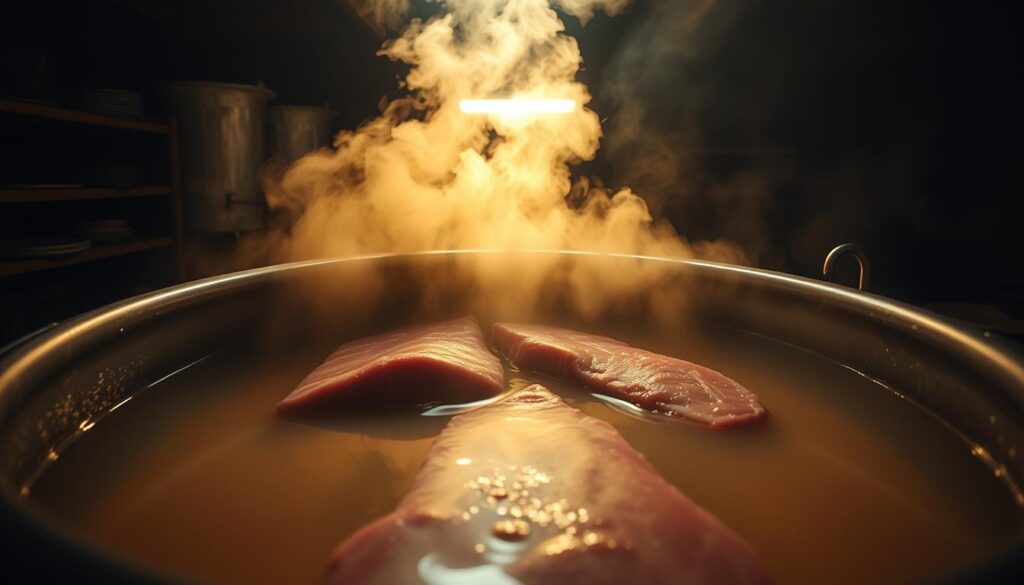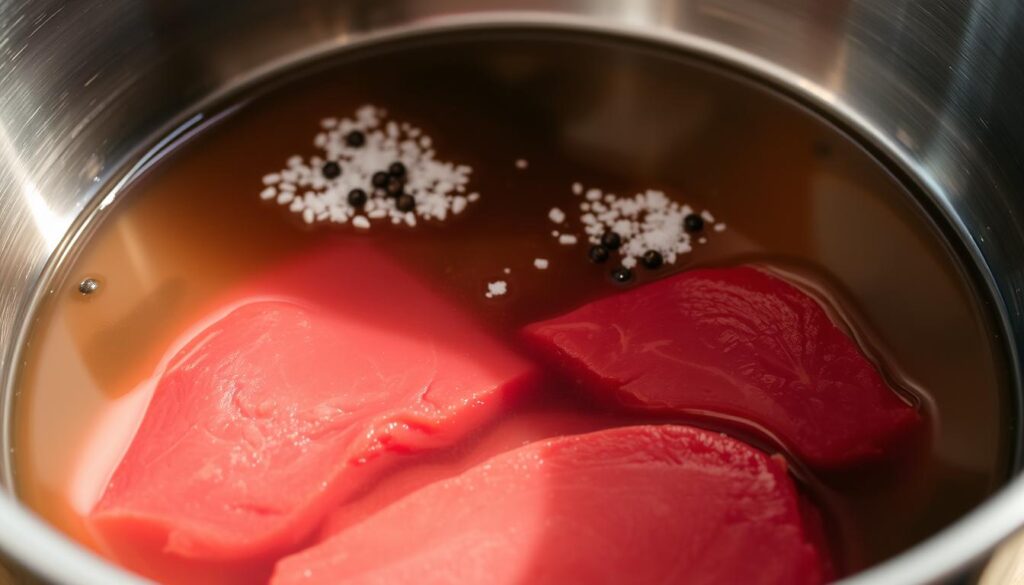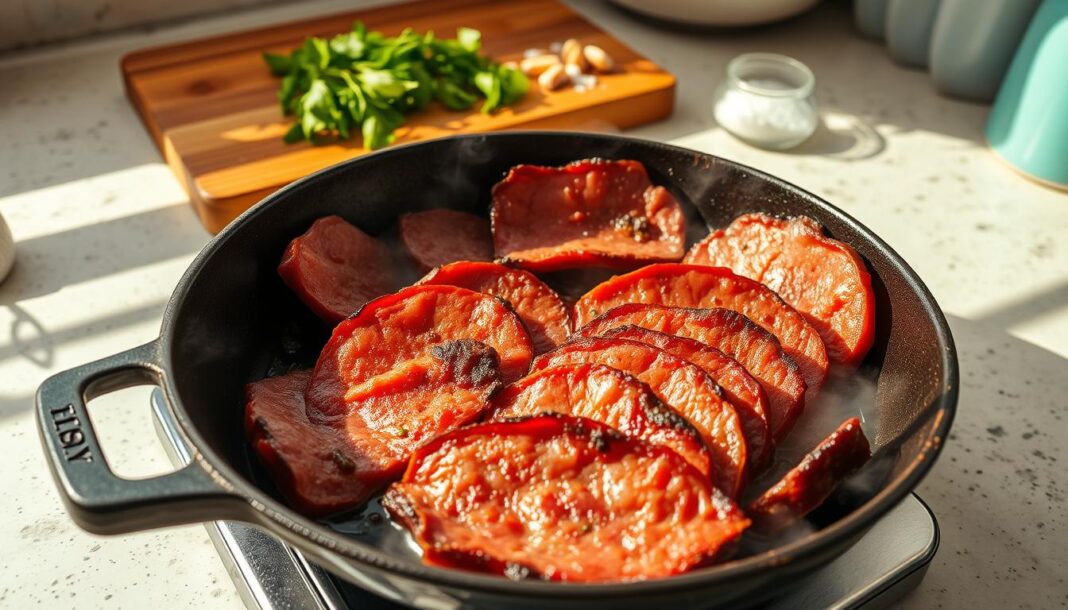We explore the fascinating science behind salt beef, a traditional dish that combines preservation techniques with flavor development to create a uniquely tender and savory meat product.
The process of creating beef brisket involves brining it in a salt solution, often with additional spices and nitrates, followed by slow cooking until tender. This transformation demonstrates the remarkable chemistry between salt, protein, and heat.
By understanding the science behind this traditional recipe, home cooks can achieve consistent, restaurant-quality results by controlling variables like salt concentration, brining time, and cooking temperature.
Key Takeaways
- Understanding the chemistry behind salt beef helps in achieving consistent results.
- The process involves brining and slow cooking to tenderize the meat.
- Controlling variables like salt concentration and cooking temperature is crucial.
- The transformation of tough cuts into succulent meat is a result of the interaction between salt, protein, and heat.
- Salt beef represents one of humanity’s oldest food preservation methods.
- The science behind salt beef allows for the creation of a uniquely tender and savory product.
Understanding Salt Beef: A Culinary Tradition
As a method of preserving beef, salt beef has played a crucial role in shaping the culinary landscape across different cultures. At its core, salt beef is about transforming tougher cuts of meat into tender, flavorful dishes.
What Is Salt Beef?
Salt beef is fundamentally a preserved meat product created by curing beef, typically brisket, in a salt solution. This process results in a distinctively flavored dish that’s both tender and savory when properly prepared. The use of salt is crucial as it draws moisture from the meat, creating an environment inhospitable to bacteria while infusing the beef with flavour.

Historical Origins and Cultural Significance
The historical origins of salt beef can be traced to multiple cultures, with particularly strong traditions in Jewish communities where it developed partly as a method of koshering meat by drawing out blood. In Newfoundland, it’s a staple in traditional meals like Jiggs Dinner. The technique traveled with immigrants, creating regional variations across different cultures, and resulting in various beef recipes. The process typically takes several days to weeks, with meat sitting in a brine solution before being slowly cooked until tender, making it a significant part of many cultural food traditions.
By understanding the salt curing process and its effects on beef, we can appreciate the science behind creating tender and flavorful dishes that have become central to various cuisines. The art of making salt beef involves a simple yet precise recipe that has been refined over generations.
The Science of Salt Preservation
At its core, salt preservation relies on a simple yet effective principle: osmosis. This process is crucial for drawing water out of bacterial cells, thereby preventing spoilage and extending the shelf life of meat.
How Salt Preserves Meat
Salt preservation works by creating an environment where water is drawn out of bacterial cells through osmosis, effectively preventing them from multiplying and causing spoilage. When meat is submerged in a brine solution, a two-way exchange occurs: water moves out of the meat while salt and other flavoring compounds move inward.
The Role of Nitrates in Curing
Nitrates, often in the form of Prague Powder #1 or curing salt, play a crucial dual role in the curing process. They inhibit the growth of harmful bacteria while maintaining the meat‘s appealing red color. The typical ratio is 94% salt to 6% nitrite, a balance critical for both food safety and flavor.
Osmosis and Flavor Development
Beyond preservation, osmosis significantly contributes to flavor development. As salt breaks down proteins in the meat, new flavor compounds are created, and tough connective tissues are tenderized. The time meat spends in the brine directly affects its salt content and flavor profile.

| Preservation Method | Role of Salt | Effect on Meat |
|---|---|---|
| Salt Preservation | Draws water out of bacterial cells | Prevents spoilage |
| Curing with Nitrates | Inhibits harmful bacteria, maintains color | Ensures food safety, enhances appearance |
| Osmosis | Facilitates exchange of water and flavors | Tenderizes meat, develops flavor |
For more insights into historical and modern culinary practices, including the use of salt in preservation, visit our page on Game of Thrones Recipes, where traditional techniques meet contemporary creativity.
Making Perfect Salt Beef at Home
Salt beef, a delicacy with deep roots in culinary tradition, can be easily made at home with the right guidance. We will walk you through the process, from selecting the right cut of beef to achieving tender results through proper cooking methods.
Selecting the Right Cut of Beef
The traditional cut for salt beef is brisket, particularly Irish brisket, due to its fiber structure. Brisket is ideal because it has abundant connective tissue that breaks down during cooking, resulting in a tender, flaky texture. When choosing a brisket, look for one with a good fat layer to ensure moistness.
Creating the Brine Solution
Creating an effective brine requires precise measurements. We recommend using 200g of salt for every 2 liters of water. The brine should also include Prague Powder #1 for food safety and color, along with optional aromatics like bay leaves, peppercorns, and garlic for added flavor. Bringing the brine to a boil helps dissolve the salt before cooling it down.

The Brining Process
The brining process typically takes 5-10 days. Ensure the brisket is fully submerged in the brine and refrigerated, turning it every few days for even curing. This step is crucial for developing the characteristic flavor and texture of salt beef.
Cooking Methods for Tender Results
After brining, rinse the beef thoroughly and simmer it in fresh water with aromatics like onions, bay leaves, and garlic for 2-3 hours. Maintain a gentle simmer to prevent the meat from becoming tough, allowing the collagen to convert to gelatin.
| Step | Time | Notes |
|---|---|---|
| Brining | 5-10 days | Keep refrigerated, turn every few days |
| Cooking | 2-3 hours | Simmer gently with aromatics |
Expert Tips for Salt Beef Success
As we’ve delved into the world of salt beef, we’ve uncovered expert tips that can elevate your cooking to the next level. To achieve the best results, it’s crucial to allow the finished salt beef to rest for up to a week before serving. This resting period significantly improves the flavour and texture of the meat.
Professional salt beef makers recommend resting the cooked beef for at least a couple of days. The perfect salt beef should be tender enough to pull apart easily but still hold its shape when sliced. For serving, salt beef is traditionally sliced against the grain and served warm in sandwiches with mustard and pickles.
To reduce salt content, you can place the salt beef in cold water for a couple of hours before cooking. Leftover salt beef can be stored in its cooking liquid or vacuum sealed and frozen. Experimenting with different aromatic ingredients in your brine can create signature flavour profiles. By mastering salt beef, you can expand your recipe collection and explore new cooking possibilities.


